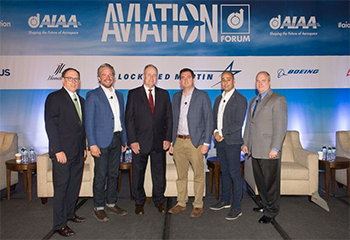Unmanned Aircraft Are Not the Wave of the Future — They Are the Present Written 6 June 2017
Panelists: Moderator Glenn Roberts, chief engineer, Center
for Advanced Aviation System Development, The MITRE Corp.; Jonathan Evans,
co-president, Skyward; Jesse Kallman, president, Airbus Aerial; Van Espahbodi,
co-founder and COO, Starburst Accelerator; Wes Ryan, manager, Programs &
Procedures (Advanced Technology), Small Airplane Directorate, FAA
by Duane Hyland, AIAA Communications (2008-2017)

Unmanned aircraft have exploded onto the aviation scene in recent years, and the industry needs to focus on the safety and security involved with these systems, a panel of experts said June 6 at the
2017 AIAA AVIATION Forum in Denver.
The
FAA predicts about 7 million total hobbyist and commercial drones will be purchased by 2020.
“All this change is happening at an incredibly rapid rate,” Glenn Roberts, chief engineer at the Center for Advanced Aviation Systems Development with The MITRE Corp., told the audience in a session titled “The Evolving Culture of Aviation.”
Panelists explained the benefits of increased drone use, including eliminating human error from aviation; better monitoring of remote areas, such as power lines and rail lines; a greater collaboration between the information technology and aviation sectors; and a nearly limitless potential for creative future applications of the technology.
But, they said, there are challenges, including ensuring safe and successful integration of unmanned aircraft into the national airspace; educating the public about the safe nature of drones; and ensuring the systems are not put to nefarious uses.
Wes Ryan, manager of Programs & Procedures (Advanced Technology) with the FAA’s Small Airplane Directorate, explained that safety is paramount, because if drones are put to “nefarious uses, nothing will kill quicker in the mind of the public.”
Jesse Kallman, president of Airbus Aerial, echoed Ryan’s concern.
“It would only take a small incident to change the public’s perception,” Kallman said.
Panelists debated the role of humans when it comes to drone technology, settling on a scenario that would leave humans in the loop. As Jonathan Evans, co-president of Skyward, explained, the human role would be “not in a cockpit, but sitting in a network control center.”
Van Espahbodi, co-founder and COO of Starburst Accelerator, urged attendees to “find ways to participate in the UAS sector, especially as the tide rises.”
